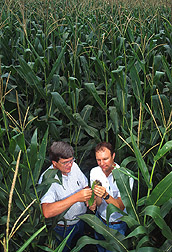This page has been archived and is being provided for reference purposes only. The page is no longer being updated, and therefore, links on the page may be invalid.
|
Read the magazine story about the sprays and other ARS projects of areawide pest management. |
New Sprays, Trap Promise to Slash Insecticide Use in America's Corn BeltBy Don ComisNovember 20, 2001 While Agricultural Research Service scientists are not about to satisfy a plant pest's craving for pumpkin by serving pie, they are only too happy to serve a family recipe to die for. The ingredients of that recipe, including cucurbitacins and other chemicals from the pumpkin and gourd or cucurbit family, attract corn rootworm beetles. One of these ingredients is in three new, low-insecticide bait sprays and a monitoring trap for the beetles. These commercial products have emerged from a 6-year joint ARS-university research and demonstration program in the Corn Belt. The bait sprays are CideTrak, made by Trece, Inc., of Salinas, Calif.; Invite, made by FFP Agriscience, Inc., of Eustis, Fla.; and SLAM, made by MicroFlo, Inc., of Memphis, Tenn. The trap is the Pherocon Corn Rootworm Trap, also made by Trece. The trap lures beetles with volatile plant chemicals. It enables farmers or consultants to make sample counts of the beetles to decide when the numbers are high enough to warrant spraying with CideTrak, Invite, or SLAM. The baits are sprayed aerially on corn leaves where the beetles eat. The sprays form drops containing cucurbitacins and insecticide. The cucurbitacins cause the beetles to feed almost exclusively on the drops, so they ingest a lethal dose of insecticide. CideTrak and SLAM get their cucurbitacins from wild buffalo gourd root powder, while Invite relies on a Hawkesbury watermelon juice ingredient. The actual active insecticidal ingredient in the three sprays is an ounce or less per acre, which is 95 to 98 percent less than in conventional sprays. The bitter cucurbitacin doesn't appeal to other insects, so it is safe for bees and other beneficial insects. The musky smell released when a cantaloupe is sliced comes primarily from cucurbitacin. To learn more about this research, see a more detailed story in the November issue of Agricultural Research magazine. ARS is the U.S. Department of Agriculture's chief scientific research agency. |

